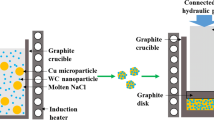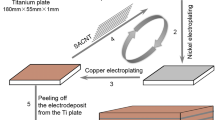Abstract
In the development of copper-based composite materials, the dilemma of improving the mechanical properties without affecting the electrical properties is an important issue that must be solved. Here, carbonized polymer dot (CPD), as a novel reinforcement, was employed to fabricate CPD/Cu (pure copper) composite via powder metallurgy technique for the first time. The microstructure analysis revealed that the CPD was uniformly dispersed in the copper matrix in the form of nanoclusters, and the nanoclusters of CPD are composed of a three-dimensional amorphous carbon (AC) network structure and inserted carbon dots (some of them have a typical graphene structure, while others not). More importantly, excellent interface combination between the CPD and copper matrix is observed due to the existing of plenty of chemical functional groups. Based on this special microstructure, our prepared CPD/Cu composite achieves excellent mechanical and electrical conductivity simultaneously. Compared to pure Cu, the ultra-tensile strength of 0.2CPD/Cu composite is increased by about 17.0%, while the elongation is only ~ 2% lower. The electrical conductivity of the composite is ~ 98% IACS, which is much higher than that of pure copper prepared under the same condition (only ~ 92% IACS). New insights into how to prepare advanced copper matrix composites with simultaneously improved overall performance will be found from our research.




Similar content being viewed by others
References
Vorobjova A, Tishkevich D, Shimanovich D, Zdorovets M, Kozlovskiy A, Zubar T, Vinnik D, Dong M et al. (2020) Electrochemical behavior of Ti/Al2O3/Ni nanocomposites material in artificial physiological solution: prospects for biomedical application. Nanomaterials 10:1
Tishkevich DI, Vorobjova AI, Vinnik DA (2020) Formation and corrosion behavior of Nickel/alumina nanocomposites. Solid State Phenom 299:100–106.https://doi.org/10.4028/www.scientific.net/SSP.299.100
Vorobjova AI, Shimanovich DL, Sycheva OA (2019) Studying the thermodynamic properties of composite magnetic material based on anodic alumina. Russ Microlectron 48(2):107–118
Vorobjova A, Tishkevich D, Shimanovich D, Zubar T, Trukhanov A (2021) The influence of the synthesis conditions on the magnetic behaviour of the densely packed arrays of Ni nanowires in porous anodic alumina membranes. RSC Adv 11:3952–3962
Xiong N, Bao R, Yi JH, Tao JM, Liu YC, Fang D (2019) Interface evolution and its influence on mechanical properties of CNTs/Cu-Ti composite. Mater Sci Eng, A 755:75–84
Chu K, Wang J, Liu YP, Geng ZR (2018) Graphene defect engineering for optimizing the interface and mechanical properties of graphene/copper composites. Carbon 140:112–123
Chen XF, Tao JM, Liu YC, Bao R, Li FX, Li CJ, Yi JH (2019) Interface interaction and synergistic strengthening behavior in pure copper matrix composites reinforced with functionalized carbon nanotube-graphene hybrids. Carbon 146:736–755
Lim BK, Mo CB, Nam DH, Hong SH (2010) Mechanical and electrical properties of carbon nanotube/cu nanocomposites by molecular-level mixing and controlled oxidation process. J Nanosci Nanotechnol 10(1):78–84
Daoush WM, Lim BK, Mo CB, Nam DH, Hong SH (2009) Electrical and mechanical properties of carbon nanotube reinforced copper nanocomposites fabricated by electroless deposition process. Mater Sci Eng A 513–514:247–253
Chen F, Ying J, Wang Y, Du S, Liu Z, Huang Q (2016) Effects of graphene content on the microstructure and properties of copper matrix composites. Carbon 96:836–842
Wei X, Tao JM, Liu YC, Bao R, Li FX, Fang D, Li CJ, Yi JH (2019) High strength and electrical conductivity of copper matrix composites reinforced by carbon nanotube-graphene oxide hybrids with hierarchical structure and nanoscale twins. Diam Relat Mater 99:107537. https://doi.org/10.1016/j.diamond.2019.107537
Akbarpour MR, Mirabad HM, Alipour S, Kim HS (2020) Enhanced tensile properties and electrical conductivity of Cu-CNT nanocomposites processed via the combination of flake powder metallurgy and high pressure torsion methods. Mater Sci Eng A 773:138888. https://doi.org/10.1016/j.msea.2019.138888
Asgharzadeh H, Eslami S (2019) Effect of reduced graphene oxide nanoplatelets content on the mechanical and electrical properties of copper matrix composite. J Alloy Compd 806:553–565
Xiong L, Shuai J, Liu K, Hou Z, Zhu L, Li W (2019) Enhanced mechanical and electrical properties of super-aligned carbon nanotubes reinforced copper by severe plastic deformation. Compos B Eng 160:315–320
Chu K, Jia CC, Li WS, Wang P (2013) Mechanical and electrical properties of carbon-nanotube-reinforced Cu-Ti alloy matrix composites. Phys Status Solidi 210(3):594–599
Zhao Q, Lei Q, Gan X, Zhang L, Zhou K (2020) Effects of the partially-unzipped carbon nanotubes on the microstructure and properties of CuCr matrix composites. Diam Relat Mater 109:108035. https://doi.org/10.1016/j.diamond.2020.108035
Babu RV, Kanagaraj S (2018) Thermal, electrical and mechanical characterization of microwave sintered Copper/carbon nanotubes (CNT) composites against sintering duration, CNT diameter and its concentration. J Mater Process Technol 258:296–309
Xiong N, Bao R, Yi JH, Fang D, Tao JM, Liu YC (2019) CNTs/Cu-Ti composites fabrication through the synergistic reinforcement of CNTs and in situ generated nano-TiC particles. J Alloy Compd 770:204–213
Liu L, Bao R, Yi JH (2018) Mono-dispersed and homogeneous CNT/Cu composite powder preparation through forming Cu2O intermediates. Powder Technol 328:430–435
Meng W, Bai X, Wang B, Liu Z, Lu S, Yang B (2019) Biomass-derived carbon dots and their applications. Energy Environ Mater 2(3):172–192
Yang H, Peng Y, Jiang L, Liu F, Jia M (2020) Carbon quantum dots sensitized Bi2O3 photoanode with enhanced photoelectrocatalytic properties. Chem Phys Lett 739:137025. https://doi.org/10.1016/j.cplett.2019.137025
Zhao WM, Bao R, Yi JH, Fang D, Li CJ, Tao JM, Li FX, Liu YC, You X, Tan SL (2020) Improving mechanical and thermal property of pure copper matrix simultaneously by Carbonized Polymer Dots (CPD) cluster reinforcement. Mater Sci Eng A 140573:100. https://doi.org/10.1016/j.msea.2020.140573
Tishkevich D, Grabchikov S, Zubar T, Vasin D, Trukhanov S, Vorobjova A, Yakimchuk D, Kozlovskiy A et al. (2020) Early-stage growth mechanism and synthesis conditions-dependent morphology of nanocrystalline Bi films electrodeposited from perchlorate electrolyte. Nanomaterials. https://doi.org/10.3390/nano10061245
Feng T, Yu G, Tao S, Zhu S, Ku R, Zhang R, Zeng Q, Yang M, Chen Y, Chen W, Yang B (2020) A highly efficient overall water splitting ruthenium-cobalt alloy electrocatalyst across a wide pH range via electronic coupling with carbon dots. J Mater Chem A 8(19):9638–9645
Lu X, Wang D, Ge L, Xiao L, Zhang H, Liu L, Zhang J, An M, Yang P (2018) Enriched graphitic N in nitrogen-doped graphene as a superior metal-free electrocatalyst for the oxygen reduction reaction. New J Chem 42(24):19665–19670
Wang Q, Cai J, Biesold-McGee GV, Huang J, Ng YH, Sun H, Wang J, Lai Y, Lin Z (2020) Silk fibroin-derived nitrogen-doped carbon quantum dots anchored on TiO2 nanotube arrays for heterogeneous photocatalytic degradation and water splitting. Nano Energy 78:105313
Xia C, Zhu S, Feng T, Yang M, Yang B (2019) Evolution and synthesis of carbon dots: from carbon dots to carbonized polymer dots. Adv Sci 6(23):1901316
Chu K, Wang F, Wang XH, Huang DJ (2018) Anisotropic mechanical properties of graphene/copper composites with aligned graphene. Mater Sci Eng A 713:269–277
Chu K, Liu YP, Wang J, Geng ZR, Li YB (2018) Oxygen plasma treatment for improving graphene distribution and mechanical properties of graphene/copper composites. Mater Sci Eng A 735:398–407
Liu L, Bao R, Yi JH, Fang D (2018) Fabrication of CNT/Cu composites with enhanced strength and ductility by SP combined with optimized SPS method. J Alloy Compd 747:91–99
Zhao WM, Bao R, Yi JH, Tao JM (2019) Fabrication of CNT/Cu based composite with twice in-situ formation from powder preparation to sintering. Mater Res Express 6(9):095088
Yang M, Lin W, Zhu HX, Zhang D, Fan TX (2017) Simultaneously enhancing the strength, ductility and conductivity of copper matrix composites with graphene nanoribbons. Carbon 118:250–260
Hu CM, Lai CM, Du XH, Ho NJ, Huang J (2008) Enhanced tensile plasticity in ultrafine-grained metallic composite fabricated by friction stir process. Scripta Mater 59(11):1163–1166
Jayathilaka WADM, Chinnappan A, Ramakrishna S (2017) A review of properties influencing the conductivity of CNT/Cu composites and their applications in wearable/flexible electronics. J Mater Chem C 5(36):9209–9237
Li W, Li D, Fu Q, Pan C (2015) Conductive enhancement of copper/graphene composites based on high-quality graphene. RSC Adv 5(98):80428–80433
Botcharova E, Freudenberger J, Schultz L (2006) Mechanical and electrical properties of mechanically alloyed nanocrystalline Cu–Nb alloys. Acta Mater 54(12):3333–3341
Sudharshan P, Vishnukanthan V, Sundararajan G (2007) Effect of heat treatment on properties of cold sprayed nanocrystalline copper alumina coatings. Acta Mater 55(14):4741–4751
Zhou D, Geng H, Zeng W, Sha G, Zhang D (2018) Effect of extrusion temperature on microstructure and properties of an ultrafine-grained Cu matrix nanocomposite fabricated by powder compact extrusion. J Mater Sci 53(7620):5389–5401
Li C, Xie Y, Zhou D, Zeng W, Wang J, Liang J, Zhang D (2019) A novel way for fabricating ultrafine grained Cu-4.5 vol% Al2O3 composite with high strength and electrical conductivity. Mater Charact 155:109775
Lyu B, Li HJ, Xue F, Sai L, Gui B, Qian D, Wang X, Yang J (2020) Facile, gram-scale and eco-friendly synthesis of multi-color graphene quantum dots by thermal-driven advanced oxidation process. Chem Eng J 388:124285. https://doi.org/10.1016/j.cej.2020.124285
Chen YC, Chiang WH, Kurniawan D, Yeh PC, Otake KI, Kung CW (2019) Impregnation of graphene quantum dots into a metal-organic framework to render increased electrical conductivity and activity for electrochemical sensing. ACS Appl Mater Interfaces 11(38):35319–35326
Kahng YH, Choi J, Park BC, Kim DH, Choi JH, Lyou J, Ahn SJ (2008) The role of an amorphous carbon layer on a multi-wall carbon nanotube attached atomic force microscope tip in making good electrical contact to a gold electrode. Nanotechnology 19(19):195705
Yang P, You X, Yi JH, Fang D, Bao R, Shen T, Liu YC, Tao JM, Li CJ (2018) Influence of dispersion state of carbon nanotubes on electrical conductivity of copper matrix composites. J Alloy Compd 752:376–380
Liu Y, Leng JF, Li ZW, Zhang PY, Wu QR (2017) Processing and Electrical Properties of Nano-Al2O3/Cu Composites. Mater Sci Forum 898:984–991
Acknowledgements
This work is supported by the Chinese National Natural Science Foundation (Grant No. 52064032), the Yunnan science and technology projects (Grant No. 2019ZE001, No. 202002AB080001), Yunnan Ten Thousand Talents Plan Young & Elite Talents Project (YNWR-QNBJ-2018-005).
Author information
Authors and Affiliations
Corresponding authors
Ethics declarations
Conflict of interest
The authors declare no conflict of interest.
Additional information
Handling Editor: Kevin Jones.
Publisher's Note
Springer Nature remains neutral with regard to jurisdictional claims in published maps and institutional affiliations.
Supplementary Information
Below is the link to the electronic supplementary material.
Rights and permissions
About this article
Cite this article
Zhao, Wm., Bao, R. & Yi, Jh. Enhancing the mechanical–electrical property simultaneously in pure copper composites by using carbonized polymer dots. J Mater Sci 56, 12753–12763 (2021). https://doi.org/10.1007/s10853-021-06116-5
Received:
Accepted:
Published:
Issue Date:
DOI: https://doi.org/10.1007/s10853-021-06116-5




